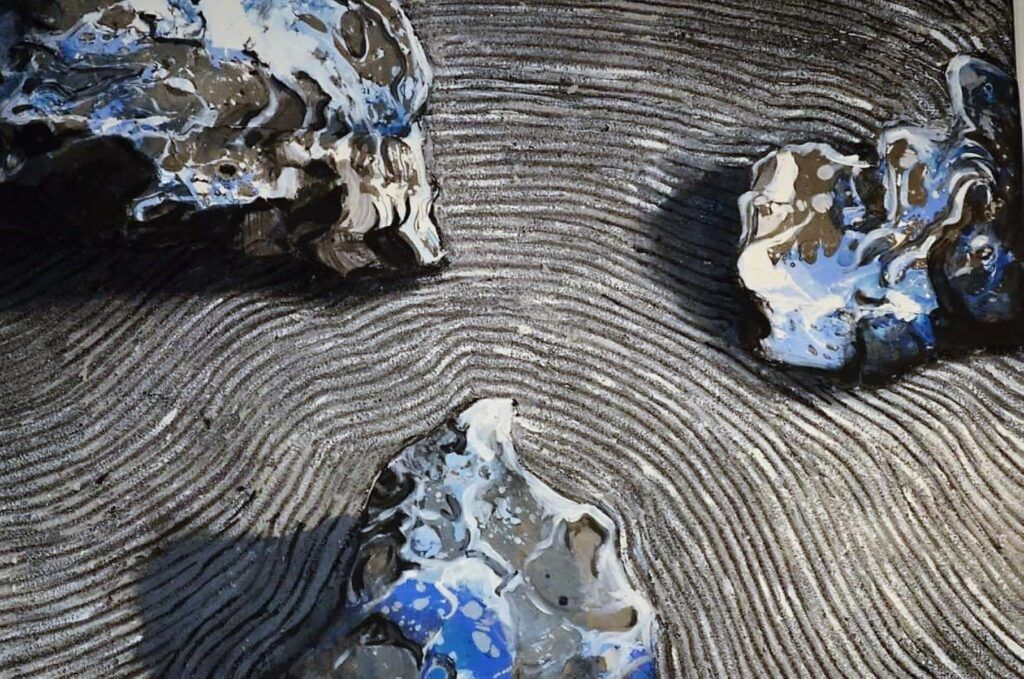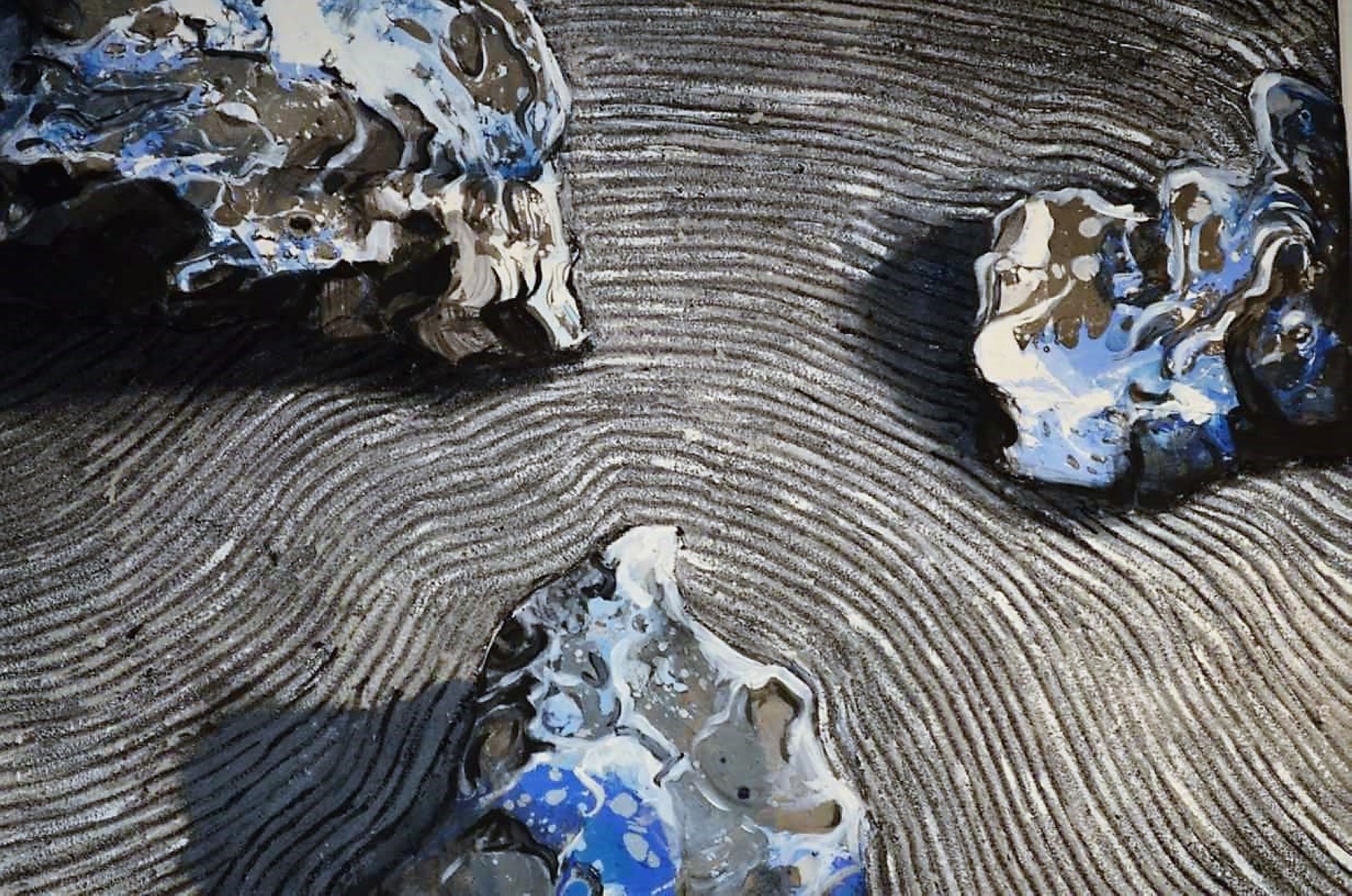words by Iwa Kruczkowska-Król
I am an artist who likes to work with people. For a musician, dancer or actor, this is obvious. However, for a visual artist – a painter – it is not so clear. Looking at us from the side-lines, it seems we are regulars in salons and galleries, but the truth about painters is that we spend most of our time alone in the studio. The preparation of an exhibition is generally done behind closed doors, and only the artist knows how much struggle and time it costs him to prepare the work. Claude Monet said a painter is a hostage to his painting, perpetually trapped in the studio. For this very reason, visual artists are solo artists. Despite all this, or perhaps because of it, there are many visual artists who work socially, collaboratively for and with others. This is a necessary counterbalance to our daily “solitary” creative reality. I know from experience that working with people can be learned, and the ability to work in a team is very useful; it gives distance from oneself but also teaches assertiveness and restraint. Tempering one’s ego is essential in teamwork, as is the ability to push through good ideas.
I was fortunate enough to start working as a production designer in theatre and film while still in college, which was an excellent school for me regarding responsibility for assigned tasks, patience and respect for others who work for one common work. I consolidated these skills during an internship abroad in the Netherlands and many artistic symposia (Slovakia, Hungary, Georgia, Jordan, Turkey, Germany) and residencies (e.g. France, Korea). Such trips helped me develop social and language skills and allowed me to observe other creative environments. This proved extremely useful when, in turn, I worked as a curator and coordinator of foreign projects with colleagues for the Association of Polish Artists and, later, in independent projects with friends in the “77” Group organising exhibitions in Poland and abroad (Düsseldorf, Nuremberg, Sofia, Vilnius). It was an excellent time to learn how to solve problems with transportation, customs documents and financial support. It became natural for me to always do something with someone and continuously work as a team to create an exciting project. During my doctoral studies, my colleagues and I began cooperating with foreign Polish centres, which often helped us with visa procedures and work transportation. As a consequence of such activities, we were able to organise many exhibitions of Polish art abroad, and our project “Exercise” was probably the first and only doctoral project of its kind aimed at the cooperation of a group of students to promote the university abroad. Exhibitions were then organised in St. Petersburg, London, Dublin, New York, Chicago, Budapest, Lviv, and Krakow.
My real breakthrough was bringing foreign artists to Poland, with whom I began to exhibit. I organised my first exhibition for Japanese artist Noriko Kawauchi, whom I met while in Japan. Exhibitions from this project were held in Krakow and Katowice. It was a small project with only an invited artist, who brought her own ceramics in a suitcase, and me. I slowly gained experience and boldness in my actions. When I started working with amateur artists from Group 18 – Obsidian in 2017, the opportunity came to initiate a project abroad with India. We were able to organise an exhibition of Polish artists in Jaipur, India. (Of course, the important thing is that, as in previous projects, it was a team effort, such projects cannot be organised alone, so it was a collaboration of the entire 18-Obsydian Group). The conclusion of this project was an Indian evening in Poland, which was an opening of Polish and Indian artists in Zabrze. The exhibition was combined with henna workshops, delicacies of Indian cuisine, fabric dyeing workshops and, of course, the opportunity to try on an Indian sari. The involvement of a whole team of people resulted in a deep sense of unity and responsibility for the project. Each artist was assigned a function. One person was responsible for communicating with the Indian side; another was tasked with proofreading the text, designing the catalogue, or even cutting the slats to display the works. Group 18 – Obsidian’s exhibition in India lasted ten days, but the project expanded to other activities; I started painting Indian motifs myself, thus organising many more related exhibitions of my own art. The international cooperation lasted until 2022, during the pandemic resulting in several online exhibitions. The joy of the experience of this project led us to start thinking about another, this time an African project. However, the pandemic meant we had to limit our search to Poland. As a result of the quarantine and sanitation regime, I started looking for contacts with artists from Africa living in Poland. We found an incredible artist, an amateur who comes from Mali and lives permanently in Cracow. We found his work and personality incredibly interesting and inspiring. The project’s theme also took us to the African Museum to learn about the art and culture of the continent. The result was a series of exhibitions organised in Krakow, Zabrze and Katowice. Group 18 -Obsydian participated in a charity concert for the construction of a school in Africa and organised a summary of the project in the form of an African evening. In parallel to the activities carried out with the 18 – Obsidian Group, I continued the African project also individually, painting paintings inspired by Africa, inviting professional artists who also experienced travel to Africa to exhibit, thus creating joint art exhibitions, often accompanied by commentary, specialists (tourist guides ). The project was guided by meetings with missionaries and doctors, discussing their experiences working in Africa and presenting photo documentation of the moments experienced.
Things don’t always happen chronologically. While collaborating on one project with Group 18 – Obsidian, I also organised other activities. Thus, when I was finishing the African project with my painting exhibition accompanied by workshops for children and adults at the Zabrze City Museum, at the same time my colleagues and I were already in the process of realising the project of the International Postal Art Exhibition “Luna Possibly Mars” dedicated to the 100th anniversary of Stanislaw Lem’s birth. It was a project aimed at international artists, carried out in a team of four and in cooperation with the Stanislaw Lem Foundation (honorary patronage) and the “Science I Like” Foundation (media patronage). The project included two exhibitions, already in the real world and not remote, and one online exhibition. Catalogues and calendars with reproductions of the works were designed and published. About 240 artists from 50 countries participated in the exhibition. At the same time, we were putting the finishing touches on the project of the international exhibition “Stuka from recycled”, which united the community of artists from Krakow and Gliwice, as well as from the USA, India, and Germany. The exhibition was held at the Ruins of the “Victoria” Theatre in Gliwice. The “Art of Recovery” project was carried out with artists we had met earlier during projects conducted during our doctoral studies. All these activities brought us much joy, and the fact that it was possible to do something despite bad fate, like a pandemic, despite logistical and financial problems, brought us even closer, artists who are thirsty for company and cooperation, so that later, as part of the tranquillity, we could again lock ourselves in the studio and devote ourselves quietly to our work.
Iwa Kruczkowska-Król born in Zabrze, the southern part of Poland. She got her university diploma with first-class honours from the painting studio of Professor Jacek Waltoś, with the annexe from artistic tapestry under the supervision of Professor Lilla Kulka. She earned her speciality stage design diploma in 2004 under the supervision of Professor Krystyna Zachwatowicz-Wajda. During 2011- 2012 she did her postgraduate studies at the Faculty of interior design and design of the Silesian University of Technology in Gliwice. Iwa got her PhD in 2017 at the Academy of Fine Arts in Cracow. Since then, she has worked at the Faculty of Architecture at the Silesian University of Technology in Gliwice. From 2004 to 2020, she participated as a production designer and costume designer in the production of theatre, feature films, shorts films, music videos, commercials, educational films and video art.
She has participated in many personal (over 30) and collective (over 270) exhibitions (many times also curating the exhibitions) in Poland, USA, Ireland, England Germany, France, Hungary, Czech Republic, Bulgaria, Lithuania, Italy, Japan, Russia, Ukraine, the Netherlands, Slovakia, Belgium, India, Switzerland, Albania, South Korea, Georgia, Jordan, Turkey. Including Mail-Art projects in Spain, Puerto Rico, Mexico, Austria, Argentina, Serbia, Kyrgyzstan, Finland, Chile, Argentina, Brazil and online projects in Australia, Nepal, China, United Arab Emirates, Indonesia, Bolivia, Egipt, Nigeria.
Awarded many times in painting competitions and honoured with creative scholarships from the City of Cracow and the Marshal of the Silesian Voivodeship.
Her work deals with painting, scenography, unique fabric and artistic education.
Iwa works in many state-run and private collections in the country and abroad.
PICTURE:
Iwa Kruczkowska „Zen”

